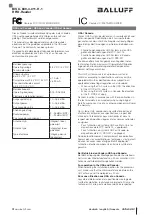
37
7.2
Defining the configuration
There are several ways to define the configuration of a controller. The easiest will be by using
the
Image maker
included in the
Console /Tools.
The way to use the image maker is
explained at the “
DREAM 2 CONSOLE GUIDE
”.
In the following chapter we describe the configuration process when executed directly from the
DREAM’S control panel or by using the DREAM simulation software that simulates the DREAM
controller on the PC. When done by the simulation software, the resulting configuration file can
be loaded into the
DREAM 2
controller through the
USB
socket as explained above in
paragraph 4.5
or through the internet by executing the “
Upload image file
” command that
can be found either at the Console/Tools/Target_tools or at the
Admin/Targets/<selected_target>/Actions.
For starting the configuration process, select Setup in
the main menu, then in the submenu select SYSTEM
CONFIGURATION. The selection is done by the
ENTER key.
Entering into the SYSTEM CONFIGURATION subject
without inserting a password enables only to watch the
existing configuration. In order to get permission for
defining a new configuration, a password is required. The
password is 139, it is not a secret password, it is only
meant to make the user think again before erasing the
previous definition and all the accumulated information.
The configuration process is executed in three steps:
Network definition –
includes the definition of the hydraulic network structure the
devices to be controlled and the relation between them.
Hardware definition –
defines the kind of hardware used in the system for controlling
the devices defined during the network definition.
Connections definition –
defines the connections table that contains the lists of all the
physical connection points of the devices defined. When the system contains only local
I/O and does not make use of any RTUs, it is very convenient to use the option of
AUTOMATIC ALLOCATION that makes the connections allocation automatically,
allocating the inputs/ outputs in a sequential manner.
















































